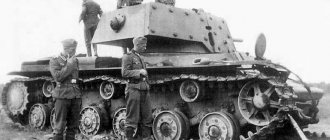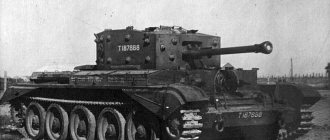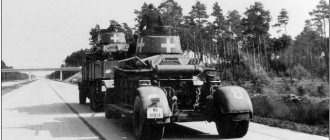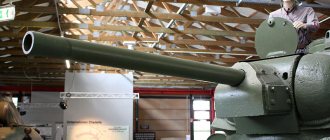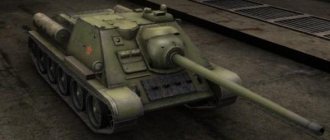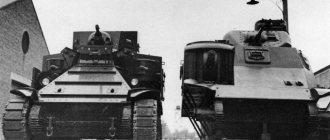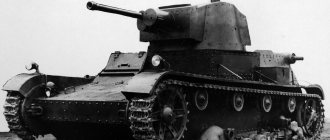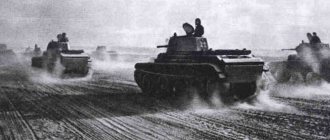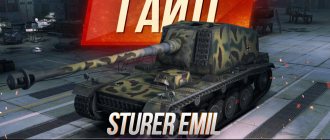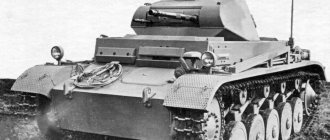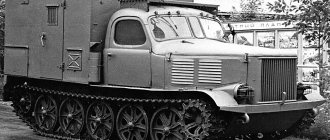The IS-2 heavy tank became one of the most famous and successful examples of USSR armored vehicles during the war. The IS-2 tank passed through all the hardships of the final stage of the Great Patriotic War with honor; it was superior to all analogues, and later became the ancestor of post-war Soviet heavy tanks.
It is worth noting that, unlike most tanks created during the war period, the IS-2 tank remained in service for a long time, surpassing even the more modern vehicles that were supposed to replace it.
History of creation
They began to think about the development of a new heavy tank in the spring of 1942. By the beginning of 1942, the KV-1 heavy tank was no longer suitable for the military for a number of reasons. It was then that the modernized PzKpfw IV and StuG III self-propelled guns with reinforced armor and more advanced guns appeared on the battlefields. The 76-mm KV-1 and T-34 guns were not enough to confidently defeat the new armored vehicles of the Wehrmacht, and after the appearance of the Panther and Tiger I tanks on the battlefields, the Red Army's need for new, more advanced tanks became even more obvious.
The project to create a new heavy tank was supervised by Joseph Kotin, one of the most experienced Soviet designers in the field of tank building. Previously, he had already gained extensive experience in designing heavy tanks, being the father of the KV tank family (Klim Voroshilov). The KV became the first mass-produced heavy tank in the world with anti-ballistic armor. But the car had its drawbacks, which included low reliability and difficult working conditions for the crew. The work on creating the IS-2 tanks was directly supervised by Nikolai Shashmurin, whom Kotin knew very well since the 1930s from working together at the Kirov plant in Leningrad.
Initially, the military was counting on a combat vehicle weighing 30 tons with a new 85-mm gun. Thus, an attempt was to be made to create a universal tank that would be distinguished by both good mobility on the battlefield and good survivability.
This is how the KV-13 tank was born, but this tank failed in tests, its chassis was unreliable, and it was also necessary to introduce a more spacious three-man turret.
In the fall of 1942, the newest German heavy tank, the Tiger, fell into the hands of the Soviet military and designers. The vehicle was practically intact and was captured by Soviet troops near Leningrad in September 1942, but the Germans managed to dismantle some of the equipment from the tank. Later, in January 1943, also near Leningrad, a practically intact tank fell into the hands of Soviet soldiers, from which the Germans not only did not remove/destroy the instruments/sights/guns, but also left a technical passport along with the tank. The emergence of information about new German heavy tanks and their capture as trophies accelerated work on the creation of Soviet heavy combat vehicles. Also, this work was spurred by the meeting of the Red Army soldiers with new models of enemy field fortification.
For example, these included armored machine-gun nests of the “Crab” type, mass-produced in Germany. The armored cap of such a machine gun nest was made entirely of armor steel and was recessed into a specially dug pit.
Taking all this into account, the Soviet forces needed a heavy tank armed with a cannon that could hit even the most well-defended targets. Conducted range attacks on captured Tigers showed that it was necessary to increase the caliber of the guns.
True, the use of more powerful guns inevitably led to an increase in the dimensions and weight of the tank. As a result, the idea of creating a new tank with high speed, firepower and armor protection was abandoned, sacrificing the speed characteristics of the tank.
Initially, the designers thought of limiting themselves to the 85-mm D-5T gun. For a medium tank, this gun was a very good solution, but Kotin insisted on installing an even more powerful gun on a heavy tank. At a distance typical for a tank battle in the Great Patriotic War, medium enemy armored vehicles could be knocked out with an 85-mm gun, but problems were already arising with heavily armored vehicles.
At a distance of 500-1000 meters, a caliber armor-piercing projectile from an 85-mm cannon could penetrate the frontal armor of a Tiger tank only with hits close to normal. Ultimately, Kotin and the team of designers working on the creation of a new heavy tank decided to install a 122 mm gun on it.
The base model was the 122-mm A-19 hull gun, which was well mastered by Soviet industry. The gun was mass-produced at Perm Plant No. 172. In the fall of 1943, a preliminary design of a new heavy tank with a 122 mm gun was ready. He impressed first the People's Commissar of the USSR Tank Industry Vyacheslav Malyshev, and then Stalin himself. The new combat vehicle created an even greater sensation among the test participants at the test site. A captured Panther was shot from a new heavy tank.
From a distance of 1,400 meters, the BR-471B 122-mm blunt-headed armor-piercing projectile confidently pierced the armor of the German “predator”, leaving serious holes in it. The hit of such a projectile in the forehead of the turret not only created a hole in it measuring 180 by 240 mm, but also tore the Panther turret off its shoulder strap; it was displaced by 500 mm relative to the axis of rotation. It is worth noting that during the Great Patriotic War, along with the designation IS-2, the name IS-122 was also used, where the index 122 just designated the caliber of the main armament of a heavy tank.
But the tank also had its drawbacks. Firstly, the rate of fire is very low for a tank gun - only 1.5-3 rounds per minute. The 122-mm D-25T tank gun had separate cartridge loading. The low rate of fire did not allow intense fire on the enemy and limited the tank's capabilities when fighting enemy armored vehicles. True, according to the recollections of tankers who fought on IS tanks, the low rate of fire of a tank in real combat conditions was usually not a problem. Another equally serious problem was the tank’s small ammunition load (only 28 rounds). For this reason, tankers very often tried to place more shells into the tank than were allowed. But even despite the existing shortcomings, much better survivability compared to all medium tanks and, most importantly, a very powerful gun, made up for the shortcomings of the vehicle and in December 1943 the IS-2 went into production.
Yuri Pasholok. IS-2 - the struggle for a place on the assembly line
Home » Books on the history of tanks » Yuri Pasholok. IS-2 - the struggle for a place on the assembly line
Books on the history of tanksLittle known and unrealized projects of tanks and other armored vehicles
boroda 08/30/2018 1174
0
in Favoritesin Favoritesfrom Favorites 0
On October 31, 1943, the experimental heavy tank Object 240 was adopted by the Red Army. This is how the evolution of the KV-1 heavy tank, which appeared back in 1939, reached its final point. The final touch to the portrait of the new vehicle was the 122-mm D-25T cannon, which was capable of fighting any Wehrmacht tank. Soviet designers of heavy tanks not only caught up with the Germans with their “Tiger”, but were also able to get ahead of them. Today's story is about the production of the IS-2 and the development of its design from the end of 1943 to mid-1944.
Heavy tanks: a new priority for ChKZ
The year 1943 turned out to be extremely nervous for the Chelyabinsk Kirov Plant. What befell Tankograd during this time was something no tank-building plant in the world could experience. This year, the plant produced as many as 6 types of tanks (KV-1s, flamethrower KV-8s, KV-85, IS-1, IS-2 and T-34) and 2 types of self-propelled guns (SU-152 and ISU-152). 3, and sometimes 4 types of combat vehicles were produced simultaneously.
This situation cannot be called normal. ChKZ, initially focused on the production of heavy tanks, was also loaded with the production of the medium T-34 in the summer of 1942. Since September 1942, the T-34 was the main product of Tankograd, and the production volume of these tanks gradually grew. The peak was October 1943, when ChKZ delivered 366 vehicles.
The launch of Object 240, officially designated IS-2, into serial production took place in a difficult environment. At the same time, the plant began producing the IS-152 (as the ISU-152 self-propelled gun was originally called in the documents). In addition, the start of production of the IS-2 (or IS-122) did not mean that the plant would immediately stop making the IS-1 (aka IS-85). Both tanks were produced by ChKZ in parallel until January 1944 inclusive. Despite the fact that the differences between the tanks at first glance seem small and consist only in the turrets, the difficult production situation became even more complicated.
Based on the results of tests of Object 240 at the Gorokhovetsky ANIOP (Artillery Scientific Test Site), a list of comments was collected regarding the placement of the crew in the fighting compartment. The commander's position turned out to be too close to the gun. After conversion to a new gun, the rear machine gun was removed from the turret, since it became extremely inconvenient to use. Due to the larger gun, it was necessary to move some elements located on the roof of the turret. Finally, the armor of the gun mount (part 240-57-39) also needed changes. Yes, the IS-2 turret (drawing number 240-57-Sb.6) is very similar in appearance to the IS-1 turret. But they were not identical.
The first version of the turret for the IS-122 was developed by the Design Bureau of Plant No. 100 in mid-November 1943. The fan on the roof of the tower, together with the cap, moved back and slightly to the right, and at the same time the installation of the MK-IV periscope device used by the loader was shifted slightly to the right and back. The gunner's MK-IV device moved slightly forward. The angle of the front roof has been reduced from 5 to 3 degrees. The loader's hatch shifted slightly, and at the same time the design of its torsion bar was strengthened. The commander's cupola moved to the left, which required making a protrusion in the roof and increasing the “pocket” in the left side of the tower, as well as changing the left handrail. The armor of the gun and the embrasure of the turret were redesigned. The general shape of the tower has also changed slightly. After minor modifications, the IS-2 turret was approved in December 1943.
There is almost a detective story connected with the first turrets for the IS-2. In a report for December 1943, Plant No. 200 mentioned the production of 90 turrets for the IS-85, without saying a word about turrets for the IS-2. And this despite the fact that ChKZ delivered 35 IS-2 tanks in December! The real picture of the production of turrets for IS tanks becomes clear only in the report of plant No. 200 for 1943. Here, in the table of defective parts, it is indicated that in 1943 the plant delivered only 71 IS-1 turrets, one of which was rejected due to the presence of shells.
Tankograd met the beginning of 1944 by building 3 types of tanks and 1 type of self-propelled guns. In addition, the prospect of producing a second self-propelled gun, the ISU-122, loomed before the plant. But gradually this difficult situation improved. The load on T-34s decreased: if in December 1943, then in January 1944 there were 185 such vehicles. Such a decrease in volumes occurred after Stalin signed Decree of the State Defense Committee (GKO) No. 4850ss on December 27, 1943 “On increasing the production of heavy tanks, artillery self-propelled guns of the IS type and on providing them with artillery weapons.”
However, it was still not possible to increase production of the IS-2 in the first month of 1944: out of 75 IS tanks produced in January 1944, 40 were IS-85. Nevertheless, in January Tankograd began preparing for mass production of heavy tanks. Workers were trained and prepared for the assembly line assembly of ICs and MIS.
At the same time, work to improve quality continued, and here ChKZ achieved some success. However, in a report for January 1944, the senior military representative of the Technical Directorate of the Main Armored Directorate of the Red Army (TU GBTU KA), engineer-colonel Davidenko, noted that there were a lot of problems, primarily organizational ones. According to the military representative, the plant did not fight sufficiently to improve quality. Despite the presence of a number of protocols approved by the GBTU KA and the People's Commissariat of Tank Industry (NKTP), design improvements and alterations were not implemented on time.
One of the reasons for this state of affairs was the abnormal relationship between ChKZ and pilot plant No. 100. ChKZ did not want to modify the designs of plant No. 100, and there, in turn, they believed that serial modification of the tank was the responsibility of ChKZ.
By January 19, 1944, the Design Bureau of Plant No. 100 had prepared a new version of the turret. The movable armor of the mask has changed: it has become wider, while the sight has moved to the left. At the same time, the fixed armor was redesigned; the protrusion under the commander's cupola became more technologically advanced. This turret began to be installed on tanks in early February 1944, but without modified armor. They appeared only in the summer of 1944. At the same time, the first version of the turret was installed on some vehicles until March 1944 (one such tank can be seen in Poznan, Poland).
In January 1944, Plant No. 200 had already delivered 72 buildings and the same number of turrets. In addition, since January 1944, this company has ceased to be the only supplier of hulls and turrets for the IS-2. From the beginning of 1944, the Ural Heavy Engineering Plant (UZTM) was again involved in hull production. In Sverdlovsk there were also problems associated with the production of the T-34. True, they stopped producing these tanks even earlier, in August 1943, concentrating on the SU-85. In January 1944, with a plan of 14 towers for the IS-2, UZTM delivered 16 units. In the same month, UZTM delivered 52 nose parts for the IS-2 hull.
From the very beginning, Sverdlovsk products were slightly different from Chelyabinsk ones. The frontal part of factory No. 200 had a casting number on the left side, and on the lower frontal sheet there were characteristic tides. At the junction of the upper and lower frontal sheets of the UZTM there was a section of the feeder, but there were no numbers on the part. There were also differences in the towers. The different shapes of the casting seam are especially noticeable, as is the absence of a casting number at the rear of the UZTM turret. In addition, the towers differed from each other in the shape of the commander's cupola.
Sverdlovsk hulls and towers began to be used by ChKZ no earlier than February 1944, since the plant had a backlog of products from plant No. 200. In February, ChKZ built 75 IS-2s, while the production situation remained tense. Even together with the ISU-152 heavy tanks and self-propelled guns, the plant still built fewer than the T-34. Only in March 1944, when the NKTP freed ChKZ from producing the T-34, did the situation begin to improve a little. True, now in the form of an expanded program for the production of ISU-152.
Extra shots per minute
While the plant in Chelyabinsk was mastering the production of the IS-2, in Sverdlovsk they were deciding how to increase the gun’s rate of fire. On November 22, 1943, a meeting was held at plant No. 9 with the participation of the enterprise management, the team of the local design bureau (KB) and the head of the experimental designs department of the People's Commissariat of Armaments (NKV), Major General A.A. Tolochkova. The development of a new version of the D-25 with a wedge bolt was discussed. The design bureau of plant No. 9 developed two versions of the shutter: with a horizontal and vertical shutter arrangement. The most successful option was considered to be a horizontal wedge bolt opening to the left: with it it turned out to be more convenient to load the tank version of the gun. It was this option that was approved for production in metal.
Around the same time, the design bureau of plant No. 9 began the development of a new muzzle brake. In total, this was already the seventh version of the muzzle brake for the IS-2 cannon. The previous version No. 5 was installed on 12 guns, and option No. 6 was installed on the main series D-25 with a piston bolt. The seventh option was designated as “especially strengthened.” It’s difficult to call this muzzle brake completely new: a very similar two-chamber muzzle brake was proposed to be used when designing a 122-mm gun on an M-30 carriage in the fall of 1942. From January 3 to January 16, 1944, the new brake was tested at the factory test site. A total of 300 shots were fired; there were no comments on the muzzle brake.
An eighth type of muzzle brake, a forged design, was also developed. But the plant refused to make it.
The first two D-25 barrels with a wedge breech were manufactured by January 1, 1944. On January 4, they went to factory tests. Test results were mixed. The muzzle brake of the first gun failed: apparently, this is what caused the appearance of the 7th version of this device. On the second system, after 401 shots, a crack was discovered in the breech.
The system with a new muzzle brake, tested with 115 shots with an increased charge, went to plant No. 100 on January 24. Factory tests continued, the system passed them, and the new type of muzzle brake was considered more successful. Already at the beginning of February, Plant No. 9 began production of the D-25 with a new type of muzzle brake and wedge bolt.
Due to the fault of plant No. 9, there was a delay in sending the experimental system, and its installation in IS-2 was delayed. When installing a system with a wedge gate at plant No. 100, the height of the turret embrasure was increased from 590 to 610 mm. This made it possible to install the gun without removing the fence. To balance the system, it was necessary to install an additional weight weighing 80 kg.
The converted tank, which received the TSh-17 sight, was tested at the Kopeisk test site. From February 11 to February 13, 50 shots were fired. With the new gun, the loader's work has become more convenient. Due to the fact that the wedge valve was smaller than the piston valve, the free volume increased. However, during testing the shutter did not work very reliably due to the use of used cartridges and cartridges with dents. Of the 34 shots fired on February 11, the shutter closed only in 5 cases. On the 34th shot, a breakdown occurred and the tank had to be returned to the factory.
The D-25 with a wedge bolt was installed on tanks from the beginning of March 1944. 145 tanks were equipped with piston-breech guns. Problems identified with the new guns were promptly resolved by Plant No. 9. The installation of a wedge valve was clearly beneficial. Tests of serial tank No. 40398 showed that the gun's rate of fire increased to 2-2.5 rounds per minute. And such an indicator was considered insufficient; work was carried out on tank guns of 100 mm caliber. However, there were no real alternatives for the D-25 at that time. This gun had good accuracy and also surpassed 100 mm guns in armor penetration.
Heavy flow
According to GKO decree No. 4850ss, by April 1944 ChKZ was supposed to reach a monthly production volume of 150 IS-2 and 150 ISU-152. Monthly production of T-34s was expected to drop to 130 units per month by this month. However, this one didn’t last long either.
Already after the first reviews from the front about the IS-2, it became clear that a new heavy tank had turned out. Now it was necessary to saturate the troops with it as much as possible.
On March 12, GKO Resolution No. 5378ss “On increasing the production of heavy tanks, artillery self-propelled IS systems, powerful tank guns and 122-152 mm shells” appeared. It was duplicated in NKTP order No. 154ss dated March 14, 1944. In accordance with these documents, from March 15, the production of T-34 at ChKZ ceased, and the volume of monthly production of IS-2 and self-propelled guns based on it was gradually supposed to increase to 500 units per month. In addition, in April 1944, production of the ISU-122 began, and gradually these vehicles were to become the main self-propelled guns based on the IS-2.
The additional 25 ISU-152 per month specified in GKO resolution No. 5378ss seriously affected the production situation in March. Despite the fact that the SB-2 workshop managed to partially launch the assembly line for the production of heavy tanks this month, production problems remained. Due to the need to increase production volumes, the tower and defective area had to be transferred to the former SB-34 workshop, previously engaged in T-34. A tank mounted in SB-2 without a turret had to be sent under its own power to another workshop, where a turret was installed on it and troubleshooting was carried out. At the same time, part of the equipment released from T-34 production was sent to other workshops. At the same time, work to improve quality continued. By April 1, it was possible to implement approximately 50–55% of quality improvement solutions, although mainly due to non-labor-intensive work.
In March 1944, the IS-2 lost its 2-shell suspension stowage and received a footrest for the commander's seat.
UZTM had to stop production of T-34 hulls and completely switch to hulls for IS and self-propelled guns based on it. Since June 1944, the plant began producing 50 sets of hulls and turrets. In the same month, at plant No. 200, the practice of producing hulls without turrets was stopped, and at UZTM, the practice of producing turrets without hulls was stopped. Starting in July, Plant No. 200 planned to produce 200 sets of hulls and turrets for the IS-2 every month. At the same time, the plant was relieved of the tasks of ensuring hull production of the ISU.
Hull production for the IS-2 was carried out not only at UZTM and plant No. 200. For example, commander's cupolas were cast at factory No. 178 from January 1944.
Work was also carried out to improve the protection of the heavy tank. At plant No. 200 they began on February 20. In March 1944, 78 of 116 hulls and 62 of 82 turrets produced by Plant No. 200 had frontal parts made of high-hardness 70L armor. At the same time, plant No. 178 began casting commander's cupolas from 70L steel. High-hardness armor also appeared on UZTM products.
At the beginning of April 1944, a third plant appeared, which mastered the production of turrets for the IS-2. It became the Mariupol plant named after. Ilyich, which was restored after the liberation of Mariupol in September 1943. Already in January, Mariupol provided the first armor, which also went to plant No. 178. By the end of April, the first batch of 83 Mariupol towers arrived at plant No. 200. True, only 35 of them could be used immediately, since the rest were overweight, and quite significant (350–400 kilograms).
However, plant No. 200 also had problems with casting. Cracks that had to be welded were a common occurrence. The Mariupol towers, according to the commission operating at plant No. 200 in May 1944, turned out to be of higher quality. Despite the fact that the steel composition differed from the specified parameters, due to the better quality of the outer surface and good density of the castings, the products of the plant named after. Ilyich turned out to be more persistent. And this despite the fact that the durability of the towers and hulls of plant No. 200 made of 70L steel turned out to be 13–14% higher than the same parts made of medium-hard armor.
Externally, the Mariupol towers looked similar to UZTM products - however, they had a casting number on the stern.
In April 1944, the reorganization of production continued at ChKZ. Another machine was put on the conveyor - ISU-122. There were problems with the supply of parts by the MX-3 workshop; the situation with rollers, tracks, cranks and some other parts was critical. An attempt to switch to a cast track ended in failure; it did not pass the tests. There was an acute shortage of people, especially in the mechanical and assembly shops.
Nevertheless, optimization of hull production and other measures allowed the plant to cope with the sharply increased plan. In April, ChKZ passed 150 IS-2 and 200 ISU (including 70 ISU-122). During this month, 11 different improvements to the tank design were introduced. In particular, the towing hooks were strengthened and the shell stowage was changed.
The installation of equipment in the machine shops was completed only on May 20. The work in May was significantly affected by the lack of progress on details. For 2/3 of the month the plant did not operate at full capacity, but for the remaining ten days it carried out the plan in emergency mode. To help with assembly, many workers from other factories in Chelyabinsk were sent to the workshops. Of course, this affected the quality. In May, ChKZ was supposed to produce 175 IS-2, 135 ISU-152 and 90 ISU-122, the last tanks from this plan were delivered by June 4.
In June, a similar situation arose: the plant completed the task to produce 200 IS-2, 130 ISU-152 and 120 ISU-122 only by July 10. This time, problems with optics and artillery weapons emerged. According to the director of the plant, the labor shortage at ChKZ at that time was approximately 5 thousand people. However, military representatives noted positive trends. The plant produced products with fewer interruptions. In June, a number of changes were also made to the design of the tank. The most noticeable of these are the new handrails. The spare tracks were moved from the stern to the front part of the hull. Around the same time, the stern lights were moved to the side plates of the hull. Somewhere in July 1944, a gun mount with wider movable armor went into production.
The July IS-2 production program was only completed on August 6. The plant produced 225 tanks, and their final delivery occurred 10 days later, on August 16. From August 1944, the plant began to switch to a new type of hull - with a straightened frontal part, although for some time cars with the old frontal part were still produced. For example, in Warsaw there is an IS-2 with serial number 240-40858, manufactured in August 1944. This tank has an old type hull produced by plant No. 200, as well as a turret manufactured in Mariupol. This tank was produced later than some of the IS-2s that have survived to this day with a straightened nose.
During operation, tanks with the old type of frontal part were gradually modernized. They received a new type of handrail for the turret, and their tracks were transferred to the front plate of the hull. This was done during a major overhaul. These changes can be clearly seen on tanks that have been preserved in Poland. They did not fall under the UKN program (“elimination of design deficiencies”) carried out in the USSR and were not brought to the IS-2M level. Thanks to this, they look like they were used during the war.
The author thanks Igor Zheltov (Moscow) and Kirill Koksharov (Chelyabinsk) for their assistance in preparing this material.
Source - https://warspot.ru/11457-borba-za-mesto-na-konveyere
Design of the IS-2 tank
The crew of the IS-2 tank was located like this: the driver sat in the bow, between two fuel tanks. At his disposal were an inspection hatch and two prismatic periscopes in the roof. Later, the hatch was replaced with a triplex glass block.
There was an evacuation hatch at the bottom of the hull behind the driver's seat. The turret contained seats for the gunner and commander (on the left side) and the loader (on the starboard side). The commander monitored the situation using six viewing slits in the commander's cupola, and the loader used the MK-IV periscope for observation.
The armor hull of the IS-2 was welded from cast and rolled armor. On early cars, the upper frontal part was “broken” - the lower part was 60 mm thick at an angle of 72⁰, and the thickness of the upper part, at an angle of 30⁰, was 120 mm. The very first battles at the beginning of 1944 demonstrated the vulnerability of such a part, and already in the spring of that year the frontal part was replaced with a straightened one, 120 mm thick with an angle of inclination of 60⁰.
The side armor had a thickness of 90mm, the rear armor plates were 60mm thick.
The armor of the cast turret had a thickness of 100mm “all around”. The IS-2 turret had an electric rotation drive; a 10P radio station and an intercom for crew members were installed in it. The powder gases generated after the shot were sucked off by a fan installed in the roof of the tower.
The tank was equipped with a 12-cylinder V-2 diesel engine, in this version designated V-2IS. The engine was naturally aspirated and developed a power of 520 hp. The fuel came from tanks in the fighting compartment; additional tanks, which were suspended from the IS-2 hull, were not connected to the fuel system (that is, the diesel fuel from them had to be poured into the main ones independently).
The manual gearbox had eight speeds (due to a multiplier), two-stage final drives were connected to a planetary turning mechanism. The tank has a torsion bar suspension.
Layout of the IS-1 heavy tank
It was identical to the KV-85: in the front part there was an OU, in which the driver sat, controlling the movement of the tank and, remotely, the fire of the forward machine gun. The BO contained the commander and the crew of the gun he controlled; in addition, the BC and partly two tanks were located here.
IS-1 drawing
A new V-2-IS diesel engine and a main tank were installed in the MTO; in addition, four reserve tanks were installed outside on the sides. The crew got to their workplaces through the tower hatches; a bottom manhole was provided for emergency exit from the “box”.
The HF was almost completely identical to that on the HF, however, the width of the tracks was 650 mm; I note that this option ensured a fairly high cross-country ability of the vehicle and almost completely eliminated the problems characteristic of its bulky prototype.
IS-1 tank
IS-1 had the following performance characteristics:
- Dimensions - 8.56 (with gun)/3.07/2.74 m.
- Weight - 44.2 tons.
- Reservation - inclined: 60-120 mm; vertical: 100; horizontal: 30 mm.
- Engine -1×520 l. With.
- Speed - 37 km/h.
- Power reserve - 150 km.
- Armament - 1×D-5T - 85 mm; 3×DT – 7.62 mm.
- Crew - 4 people.
A total of 130 copies were produced.
Armament
The main armament of the tank is a DT-5 cannon with a caliber of 122 mm, mounted on the turret axles. The aiming angles were vertical, from −3 to +20 degrees, shots were fired using a mechanical or electric trigger. The gun's ammunition capacity is designed for 28 rounds of separate loading, consisting of:
- BR-471 projectile - sharp-headed, armor-piercing, tracer, containing 156 g of TNT;
- BR-471B projectile - sharp-headed (ballistic tip), armor-piercing;
- OFD-471 - cannon high-explosive fragmentation grenade, explosive - TNT or ammotol weighing 3 kg.
The vehicle's auxiliary armament included:
- 3 DT machine guns with a caliber of 7.62 mm - coaxial with the main gun in a ball mount, a lug in the rear of the turret and a fixed-type exchanger;
- ammunition for firearms - 2520 rounds in disc magazines;
- anti-aircraft machine gun DShK 12.7 mm caliber - installed since the winter of 1945;
- Ammunition for the DShK is 250 rounds in belts.
The crew's self-defense was ensured by F-1 hand grenades. Sometimes tank crews were given a pistol with flares.
Combat use of the IS-2 tank
Clashes between Tigers and IS-2s were relatively rare, or at least there are few memories of them. However, an interesting fact is that the IS-2 entered into battle with the so-called “Royal Tiger” (Tiger II). The data on the battles is too scattered; there is no accurate information on them. It is known that these tanks collided with each other in the Budapest area in November 1944, during the Vistula-Oder operation in January 1945. Both sides suffered heavy losses.
However, the Germans recognized the superiority of the Soviet IS-2. Thus, there is an archival official order from the German command, which prohibited the Tigers from engaging in a direct clash with the IS-2. It was planned to destroy Soviet tanks from ambushes. However, such tactics were also widely used by Soviet tank crews. One thing can be said for sure: the Tigers, like the IS-2, most often looked for the most vulnerable segment on the enemy’s defense line and broke through it. Neither the Soviet nor the German command was at all eager to throw heavy tanks against each other.
By the end of the Second World War, the military already clearly understood exactly how to use heavy tanks. In December 1944, separate Guards heavy tank brigades began to be formed. They were responsible for breaking through heavily fortified defensive lines, and were also used to fight enemy tank groups.
The development of the IS-2 was the IS-3, in which all the shortcomings of its predecessor were eliminated. In particular, the vehicle received a flat turret. Although this tank did not see action during World War II, it was presented to the world at the Allied Forces Parade in September 1945, where it was named one of the best tanks in the world.
This machine showed that the Soviet Union, having paid a huge price in millions of human lives, gained during the war years colossal experience in tank building, which no other country had in its entire history.
Creation of IS-1
The history of the IS began in February 1943, when the Panzerwaffe first used the latest Pz. VI and it turned out that Soviet tanks, being qualitatively inferior in protection and firepower, were simply not able to withstand them.
Therefore, in early March, the Grabin TsAKB received an order, first to re-equip the KV with a more powerful gun, and when it became clear that the design features of the serial Voroshilov simply did not allow this to be accomplished, to create a new tank, as unified as possible with it.
Tank IS-1
The IS prototype (a reconfigured KV-13) was rolled around a muddy spring training ground with the usual 76-mm ZiS-5, but when the situation with the Tiger’s armor became clear in mid-April, experiments began on installing 85- and 122-mm barrels on the tank. Of course, this led to changes in the design of the turret, so its version, even with the D-5T gun, required strengthening the hull of the “thirteenth”, which as a result grew in length by 420 mm.
In August, the IS-1, equipped with a new art installation, was demonstrated to the country's highest military-political establishment and on September 4 it was officially adopted by the Red Army.
Modifications
The released IS-2 tanks, despite the design differences, were not separated into separate modifications. Only in 1957, after the decision was made to modernize the vehicles, the IS-2M version appeared - the vehicles were converted into it during a major overhaul.
The IS-2M was equipped with new V-54K engines, a gearbox oil cooler, and night vision devices. The rear machine gun was abolished, the ammunition load was increased (increased to 35 rounds), and the external tanks included a general power supply circuit. All surviving vehicles were brought to the new standard, including the IS-2 of the first production with a “broken” frontal part.
Variants such as “IS-2Sh” appearing in some online games are fiction.
Main modifications of IS-1
All produced vehicles were almost completely identical, so there is no need to talk about modifications to the tank. However, I consider it necessary to note that the ISU-152 was developed on the basis of the IS-1, in addition, there is a version that the later ISU-122 was also created on the Stalin-1 chassis.
However, despite some unification with it, it would still be more correct to consider that the prototype of the “one hundred and twenty-second” was the IS-2, which was “brought to life” simultaneously with its conversion, thus “having” many of its technical solutions onto the self-propelled guns.
IS-1
Performance characteristics in comparison with enemy analogues
The only analogue of the IS-2 during the war was actually the famous Pz.VIB - “Royal Tiger”. Let's compare their main tactical and technical characteristics.
| IS-2 | Pz.VIB | |
| Weight, t | 46 | 70 |
| Length, m (hull/with gun) | 6,7/9,8 | 7,3/10,2 |
| Height, m | 2,6 | 3 |
| Maximum armor thickness, mm | 120 | 150 |
| Armament | 120mm cannon, 12.7mm machine gun, 3x7.62mm machine gun | 88 mm cannon, 3x7.92 mm machine gun |
| Maximum speed, km/h | 37 | 38 |
| Cruising range, km | 240/160 | 150/70 |
It is easy to see that in terms of mass and size parameters, the IS-2 was inferior to the Tiger 2 - that is, it weighed 20 tons less and was a little more compact. This gave it both better mobility and cross-country ability, even with a less powerful engine.
Of course, the Tiger had more ammunition (up to 84 rounds) and a higher rate of fire, but in practice these qualities were not usually decisive in tank duels.
The main thing is that every “Royal Tiger” released literally ruined the German industry, despite the fact that there was not much use from it on the fronts.
The IS-2 turned out to be a very successful machine precisely for the period of the war in which it was used.
It was in offensive operations that this mobile but well-protected vehicle with a powerful long-range cannon showed its best side. In a sense, it became the heir not to the KV-1, but to the KV-2, a powerful assault tank, having, unlike its “ideological ancestor,” a huge influence on the course of the war.
IS-2 tank in popular culture
The heavy tank was used in the films “Father of a Soldier” as an independent model. Several films were restyled to depict different cars. In “Blockade” - KV-1, in “Tank “Klim Voroshilov” - KV-2, in “In War as in War” - Panther, in “White Tiger” - Tiger. The Pravda team from the animated cartoon Girls und Panzer rode this exact model.
The creators of computer games - simulators and strategies - idealize the IS-2, reflecting far from real performance characteristics. The tank can be seen in World of Tanks, Blitzkrieg, Sudden Strike, Order of War, RUSE and others.
The Soviet heavy vehicle became a worthy successor to the KV-2 attack aircraft. Despite its massiveness and external clumsiness, the weapons turned out to be effective during the offensive. Mobility, good protection and a powerful long-range cannon made the tank a real striking force of the Red Army.
IS-1 rating
Here I should note that in terms of countering the latest German armored vehicles, the Stalin-1 was not much different from the KV-85: for example, they both had an 85-mm barrel that was not the most suitable for a heavy tank and, despite some increased armor, the IS-1 remained highly vulnerable to fire from German long-barreled guns.
Thus, we have to conclude that this tank was not nearly able to change the balance of power on the battlefield the way the KV-1 and T-34 did two years earlier, by and large becoming only a milestone towards the creation of a more advanced IS- 2.
